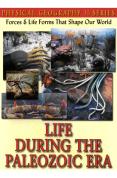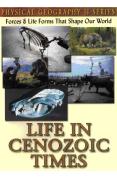 Physical Geography - Life During The Paleozoic Era | DVD | (25/11/2012)
from £26.98
| Saving you £-1.99 (-8.00%)
| RRP
Physical Geography - Life During The Paleozoic Era | DVD | (25/11/2012)
from £26.98
| Saving you £-1.99 (-8.00%)
| RRP Discover the Forces and Life Forms that Shape our World! This program explores the Paleozoic Era from the Cambrian time - over 600 million years ago. It looks at common fossils found in the United States and investigates the origin of these animals and how Paleontologists have classified them according to their various characteristics. Students will discover the fossils record artist drawings and dioramas of life in the Cambrian Ordovician Silurian Devonian Mississippian Pennsylvanian and Permian Periods. Discover plant life marine life and land life including diatoms algae mosses ferns cycads brachiopods trilobites crinoids insects reptiles ammonites sharks and fish. This program also discusses mass extinction theories and shows how the continents have moved.
 Physical Geography II-Waters of the World | DVD | (25/11/2012)
from £N/A
| Saving you £N/A (N/A%)
| RRP
Physical Geography II-Waters of the World | DVD | (25/11/2012)
from £N/A
| Saving you £N/A (N/A%)
| RRP Discover the Forces and Life Forms that Shape our World. Most people know that water is unevenly distributed over the Earth's surface in oceans rivers and lakes but few realize how very uneven the distribution actually is. The World's oceans - 139 square miles of it - contain 317 million cubic miles of Saltwater. The atmosphere is another kind of ocean and moves water vapor around the world until it falls as precipitation. This program examines the Hydrologic Cycle and shows the major water movement in the United States. It also examines how ground water stores and releases water and looks at lakes major river systems in the World and the World's estimated water supply.
 Physical Geography - Life In Cenozoic Times | DVD | (25/11/2012)
from £26.98
| Saving you £-1.99 (-8.00%)
| RRP
Physical Geography - Life In Cenozoic Times | DVD | (25/11/2012)
from £26.98
| Saving you £-1.99 (-8.00%)
| RRP Discover the Forces and Life Forms that Shape our World! This program looks at the progression of life forms during the Cenozoic era - the Age of Mammals. This program shows the development of mammal life forms in the Tertiary and the Quaternary periods and how life forms adapted to conditions during the Paleocene Eocene Oligocene Miocene Pliocene and Quaternary periods.
 Physical Geography II-Fossils Rocks & Time | DVD | (25/11/2012)
from £16.85
| Saving you £8.14 (32.60%)
| RRP
Physical Geography II-Fossils Rocks & Time | DVD | (25/11/2012)
from £16.85
| Saving you £8.14 (32.60%)
| RRP Discover the Forces and Life Forms that Shape our World. People who study Earth's history use a type of calendar called the geologic time scale. It looks very different from the familiar calendar. In some ways it is more like a book and the rocks are its pages. Some of the pages are torn or missing and the pages are not numbered but geology gives us the tools to help us read this book. In this program students will discover the relative time scale the various forms of life in the rock layers and explore the Numeric Time Scale. This program also discusses the three main concepts which are important in the study and use of fossils: - Fossils represent the remains of once-living organisms. - Most fossils are the remains of extinct organisms. - The kinds of fossils found in rocks of different ages differ because life on Earth has changed over time.

Please wait. Loading...
This site uses cookies.
More details in our privacy policy